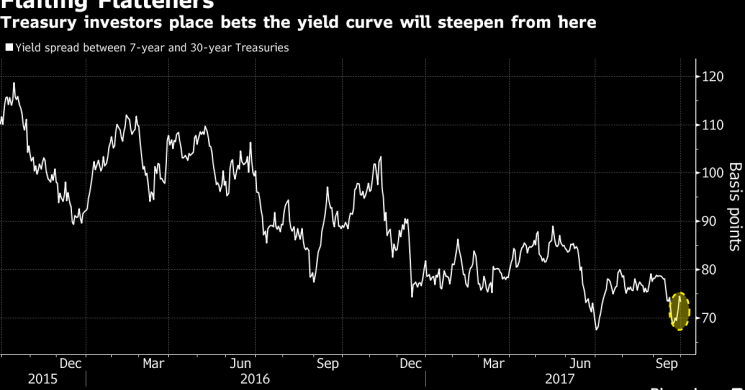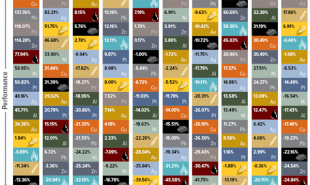
Spot Gold is trading $1288 up overnight in what can so far be considered a small bounce and an echo of sell the rumor , buy the news if the recent tax plan had anything to do with it.
Trump's tax plan amounts to fiscal stimulus which will make it easier for Yellen to tighten rates once again. The result is a projected stronger USD even as credit imbalances increase and bond yields rise.
From CNBC:
Gold touched a six-week low on Thursday after the dollar and U.S. bond yields rose on proposed U.S. tax reforms and strong economic data that supported the case for another U.S. interest rate hike this year.U.S. stocks rose and the dollar touched its highest level since mid-August before slipping as markets bet President Donald Trump's tax-cutting plan could accelerate economic growth.
The logic here is higher bond yields are not an indication of inflation but a product of yield curve steepening. If one believes the Fed has things under control, then this makes bonds compete with gold as they give a yield.
Additionally, a stronger dollar makes gold more expensive for holders of other currencies, while higher bond returns reduce the attractiveness of non-yielding bullion. Interest rate increases raise bond yields and tend to boost the dollar.
I'm fact, some believe this implies a lowering of the 2% "inflation target" the Fed has stated over the past years These developments are not something gold can thrive on," said Saxo Bank analyst Ole Hansen. "It's natural we see weakness coming through."
Tax Cuts Prompt Positioning Rethink
Bond bears have ample ammunition this week after President Donald Trump unveiled his tax-overhaul plan, spurring a rethink of the U.S. fiscal stance and monetary tightening. Most economists agree that the plan would increase the federal government’s budget deficit, defying Treasury Secretary Steven Mnuchin’s assertion that the stronger growth would more than make up for the shortfall. Up until this week traders didn’t price in any enlarged borrowing needs from tax reforms. They’re also weighing a potential supply jolt from the Federal Reserve’s plans to reinvest fewer maturing proceeds from its bond holdings back into the market. It’s not all bad news: credit investors can look forward to goodies including a one-time repatriation tax on profits that U.S. companies have accumulated offshore.

Yield Curve Slowly Steepens
The spread between long- and short-term U.S. Treasury bonds has swelled in recent sessions as investors wager that the recent bout of yield-curve flattening is over. One trader has booked paper profitsof more than $10 million on the steeping trade, while bets that tax legislation will see the light of day have helped push the 10-year Treasury yield above its 200-day moving average. Still, traders flocked to the Treasury Department's monthly auction of $28 billion in seven-year notes Thursday, underscoring the health of the market.
Monetary Patience Fuels Bulls
Subdued price pressures come at an inflection point in the Fed’s post-crisis stance as it pushes ahead with raising rates and shrinking its balance sheet even as Chair Janet Yellen concedes lowflation is a “mystery.” That’s giving fuel to some long-dated bond bulls, despite this week’s steepening yield curve. They cite the prospect that the Fed is implicitly targeting a lower inflation rate, and thereby risks marginally slowing down output and price pressures down the road. The European Central Bank is also mulling slowing stimulus yet doesn't foresee inflation returning to its goal anytime soon. That’s giving some investors the impression that monetary officials are in no rush to hit price mandates, according to Citigroup Inc. economists. What’s the practical difference in the near-term between this patient approach and cutting inflation targets through the backdoor, bond bulls ask. In any case, strategists at JPMorgan Chase & Co. are betting ample central-bank liquidity will help underpin bond prices in years to come, even as the Fed pulls back.
Leveraged-Loan Supply Eclipses 2016
Animal spirits are out in full force in the global leveraged-loan market, with booming volumes and ever-weakening covenants. Issuance in Europe has already outpaced 2016, after a flurry of merger and acquisitions activity helped push institutional volume to 54.3 billion euros ($64 billion) this week, a post-crisis high. Defaults are low and the benign economic backdrop is capping premiums in public markets across fixed-income products. But here's why one reason bears fear rising market froth: Borrowers in the $1 trillion U.S. leveraged-loan market have so much power to dictate aggressive pricing terms to ever-compliant lenders that when an offering comes with decent protections, investors worry there may be something wrong with the deal.
All Quiet on Emerging-Market Front
The Fed’s hawkish posture gave emerging-market equity bears fodder this week but credit markets remain resilient. Sure, there’s been a modest uptick in the cost of protecting lenders from default and the number of developing-nation currencies that are posting negative carry returns has risen. But the extra yield investors demand to own developing-nation sovereign bonds rather than U.S. Treasuries has been relatively steady despite Janet Yellen’s pronouncements over the past two weeks. Asian sovereign bond spreads, meanwhile, are close to a decade-low. For now, those who say indiscriminate capital flows have compressed premiums and the market buffer for event risks are still in a minority as debt bulls tout growth and inflation-adjusted yields comfortably outpacing developed markets. Underscoring this pent-up demand for exposure to emerging-market sovereign paper, Saudi Arabia raised $12.5 billion this week from its second dollar bond sale of the year as the kingdom diversifies financing amid an economic overhaul. Meanwhile, markets continue to expect a default in Venezuela but history suggests there’s no guarantee it will unseat President Nicolas Maduro from office despite widespread economic misery.
Read more by Soren K.Group







